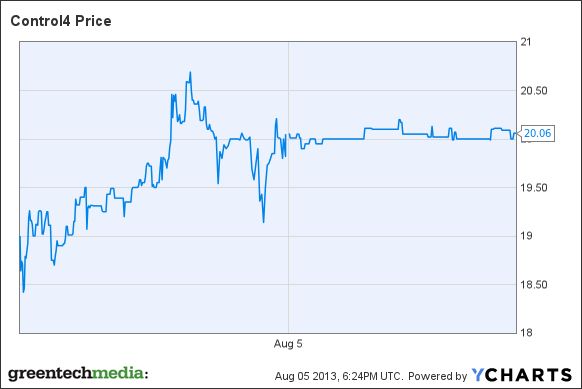Connected home company Control4 held its initial public offering on Friday -- and, at least in this brief window, it appears to have pulled off a winner.
The Salt Lake City-based maker of hardware and software that links entertainment, security and other household systems into a controllable digital platform raised $64 million in its IPO, offering some 4 million shares at its midpoint target price of $16 per share. That set the company’s overall valuation at about $400 million, far higher than its initial valuation target of $225 million set in its July 1 S-1 filing with the U.S. Securities and Exchange Commission.
Shares of the company, traded under the symbol CTRL on the Nasdaq exchange, then rose to more than $20.50 per share on Friday, and have so far hovered in the $19.50 to $20 range in early Monday trading. For a company in a still-nascent industry, and which has yet to show a profit in its ten-year history, it’s an impressive showing.
It’s also a good sign for investors in Control4, which had raised about $75 million since its 2004 founding. Early venture capital investors in the company included Frazier Technology Ventures, vSpring Capital and Thomas Weisel Venture Partners, and were joined by Foundation Capital Partners in a 2005 Series C round of $15 million. In 2009, Control4 raised $17.3 million from strategic investors including Best Buy Capital, the investment arm of the electronics retailer, as well as Mercato Partners and University of Utah-linked University Venture Fund, and in 2011 the company raised $25 million from strategic investors including Cisco (CSCO).
What Control4’s success so far means to the home energy management sector is less clear, however. Control4’s technology is now installed in about 120,000 homes across the country, giving it a significant market share in a still-new market. But while the company did raise money and set up utility partnerships on the home energy management front back in 2008 and 2009, it publicly abandoned those efforts last year.
Instead, it decided to concentrate on what its customers and dealer/installer partners really seem to want: home entertainment, home security, and the ability to manage all these home systems via mobile devices, home computers and other such tools of the modern age.
Control4 isn’t alone in making these kinds of decisions. Homeowners tend to care a lot more about comfort, safety and convenience than they do about reducing electricity bills that still add up to a relatively tiny portion of overall household expenses. Energy-specific home monitoring and management platforms from Google and Microsoft have been launched with great fanfare, only to fold quietly after being unable to convince homeowners to sign up.
Likewise, the rush of venture capital into home energy management startups has yet to yield any significant breakthroughs in terms of realizing a return on that investment, though startups like Tendril Networks continue to soldier on. At the same time, other energy-focused startups have been acquired by companies that are focused on home security and automation -- witness New York startup EnergyHub’s acquisition by home automation startup Alarm.com earlier this year.
That doesn’t necessarily mean that Control4 customers can’t take advantage of their systems to save energy, or that the idea of expanding its core capabilities to energy management is completely dead.
Take Control4’s 2011 partnership with Cisco to join the networking giant’s Smart+Connected Communities initiative. Control4 CEO Martin Plaehn told us in early 2012 that its partnership with Cisco was mainly focused on using video and telecommunications technology to connect residential customers to various business and government services, as demonstrated in connected city projects like Cisco’s work in the South Korean city of Songdo.
While those projects do offer potential avenues for energy management, Cisco has said that the business models have yet to be worked out for delivering high-tech connectivity to apartments and cities. Still, once those high-value technology connections have been established, they could serve to monitor and manage energy usage as well -- at least in theory.
The same goes for a long list of connected home service offerings. Comcast’s Xfinity Home security service, for example, includes a partnership with startup EcoFactor, which has technology to automate home thermostats to save energy without requiring homeowner input. Home improvement retailer Lowe’s has joined forces with U.K.-based startup AlertMe on its cloud-connected home automation platform, dubbed “Iris,” and other home automation service offerings, such as those being offered by telcos like AT&T and Verizon, also include partnerships that could expand to include energy as a focus.
Likewise, U.S. home security company Vivint, which was acquired for $2 billion by private equity form Blackstone Group earlier this year, has been making its foray into home solar systems and energy management offerings on top of its core services. While going green and saving the planet remain worthwhile aspirations for the home automation industry, it increasingly appears that the path to achieving those goals will come as an afterthought, or an add-on, to giving homeowners the things that matter to them most: protecting their families, and providing the convenience and comfort of a digitally connected home.
Control4 introduces its smart home automation features:




